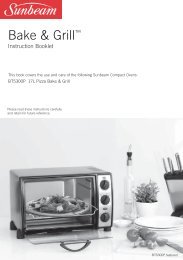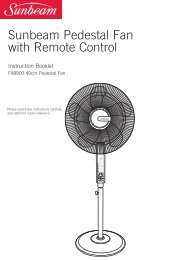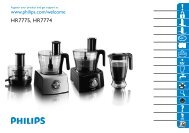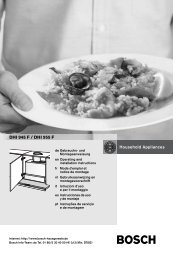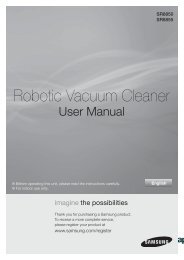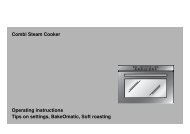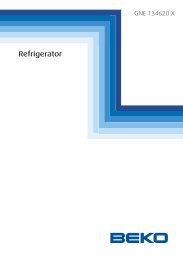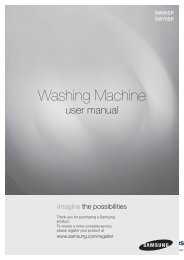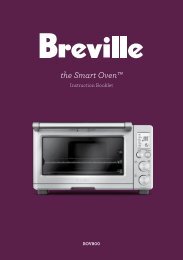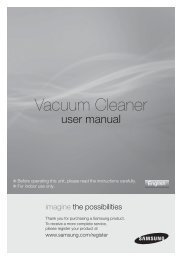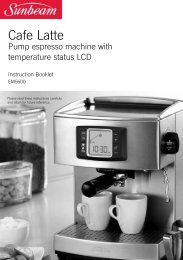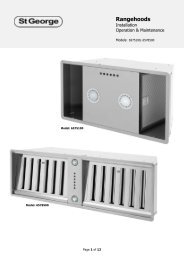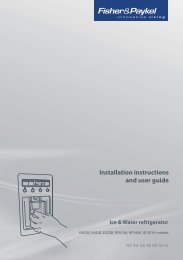E521TRT3 Operating Instructions - Appliances Online
E521TRT3 Operating Instructions - Appliances Online
E521TRT3 Operating Instructions - Appliances Online
You also want an ePaper? Increase the reach of your titles
YUMPU automatically turns print PDFs into web optimized ePapers that Google loves.
Refrigerator & Freezer<br />
Installation instructions<br />
and User guide<br />
NZ AU UK IE PAC
Active Smart models<br />
635 mm wide E331T, E372B, E381T, E402B, E411T, E415H<br />
680 mm wide E406B, E413T, E440T, E442B<br />
790 mm wide E521T, E522B<br />
Cyclic and Compact models<br />
525 mm wide P120, E169T, C170T, C190, E240B, E249T, C270<br />
635 mm wide C373, C450, E373, E450<br />
Vertical freezer models<br />
525 mm wide E150, E210<br />
635 mm wide E308, E388<br />
Chest freezer models<br />
Slimline H215, H275, H320<br />
Standard H160, H220, H280, H360, H510, H701<br />
Important!<br />
This User Guide is to be used for all refrigerator/freezers. It contains all the general<br />
information required for the operation of your refrigerator/freezer.<br />
A User Guide is provided with the Ice & Water refrigerator. This booklet contains additional<br />
specific information about the ice and water functions on the refrigerator.
Contents<br />
General operating instructions – all products<br />
Safety and warnings 2<br />
Installation instructions 4<br />
Moving or storing your appliance 8<br />
Door conversion 8<br />
Active Smart refrigerators<br />
<strong>Operating</strong> instructions 9<br />
Special features 11<br />
Cleaning care 13<br />
Cyclic and Compact refrigerators<br />
<strong>Operating</strong> instructions 17<br />
Special features and maintenance 18<br />
Cleaning care 19<br />
Vertical freezer<br />
<strong>Operating</strong> instructions 22<br />
Chest freezers<br />
<strong>Operating</strong> instructions 23<br />
Special features and maintenance 24<br />
Food care – all products<br />
Storing food in your refrigerator 25<br />
Storing food in your freezer 27<br />
Problem solving checklist 29<br />
Manufacturer’s Warranty 31<br />
Customer Care 33<br />
Important!<br />
SAVE THESE INSTRUCTIONS<br />
The models shown in this User Guide may not be available in all markets and are<br />
subject to change at any time. For current details about model and specification<br />
availability in your country, please visit our local website listed on the back cover<br />
or contact your local Fisher & Paykel dealer.<br />
1
2 Safety and warnings<br />
To reduce the risk of fire, electric shock, or injury to persons read the IMPORTANT SAFETY<br />
PRECAUTIONS before operating this appliance.<br />
Use this appliance only for its intended purpose as described in this User Guide.<br />
Important safety precautions<br />
Warning<br />
When using this appliance always exercise basic safety precautions including the following:<br />
Danger<br />
■■ This appliance is not intended for use by persons (including children) with reduced physical,<br />
sensory or mental capabilities, or lack of experience and knowledge, unless they have been given<br />
supervision or instruction concerning use of the appliance by a person responsible for their safety.<br />
■■ Young children should be supervised to ensure they do not play with the appliance.<br />
■■ Risk of child entrapment. Before you throw away your old refrigerator or freezer:<br />
– Take off the doors<br />
– Leave the shelves in place so that children may not easily climb inside.<br />
■■ The manufacturer’s installation instructions for product and cabinetry ventilation must be<br />
followed when installing the appliance.<br />
■■ Keep ventilation openings, in the appliance enclosure or in the built-in structure, clear of<br />
obstruction.<br />
■■ Do not use mechanical devices or other means to accelerate the defrosting process, other than<br />
those recommended by the manufacturer.<br />
■■ Do not damage the refrigerant circuit.<br />
Disposal<br />
■■ Extreme care must be taken when disposing of your old appliance to avoid hazards. The<br />
refrigerant gas must be safely removed and for the safety of young children, remove doors.<br />
■■ Your Fisher & Paykel Authorised Repairer will be able to give advice on environmentally friendly<br />
methods of disposing of your old refrigerator or freezer.<br />
Electrical<br />
■■ Your new appliance must be properly installed in accordance with the installation instructions<br />
before it is used.<br />
■■ Never unplug your refrigerator or freezer by pulling on the power cord.<br />
■■ Always grip the plug firmly and pull straight out from the outlet.<br />
■■ Do not plug in any other appliance at the same power point as your refrigerator or freezer or use<br />
extension cords or double adapters.<br />
■<br />
■ Repair or replace immediately all electric service cords that have become frayed or otherwise<br />
damaged. Do not use a cord that shows cracks or abrasion along its length or at either the plug<br />
or appliance end.<br />
If the power supply cord is damaged, it must only be replaced by your Fisher & Paykel Authorised<br />
Repairer because special purpose tools are required.
■■ When moving your appliance away from the wall, be careful not to roll over or damage the<br />
power cord.<br />
■■ Unplug your refrigerator or freezer before cleaning or replacing the lightbulb.<br />
■■ Do not use electrical appliances inside the food storage compartments of the appliance, unless<br />
they are of the type recommended by the manufacturer.<br />
Important!<br />
Your refrigerator is designed to operate for many years without the need for service checks.<br />
However, if your refrigerator is malfunctioning, have it attended to by your Fisher & Paykel<br />
Authorised Repairer as soon as possible. All electrical repairs must be carried out by an<br />
adequately trained service technician or qualified electrician.<br />
Storing food and drinks<br />
■■ DO NOT store explosive substances such as aerosols cans with a flammable propellant in this<br />
appliance.<br />
■■ Never store volatile or flammable materials in your refrigerator or freezer as they may explode.<br />
■■ Never freeze liquids in glass containers. Liquid expands during freezing, which may cause the<br />
container to explode.<br />
■■ Never freeze carbonated drinks. They may explode.<br />
■■ Do not consume food if it is too cold. Food removed from the freezer compartment may be cold<br />
enough to cause damage when brought into contact with bare skin, eg frozen ice cubes.<br />
Power failure – food safety<br />
■■ Do not refreeze frozen foods that have thawed completely. Follow the recommendations below if<br />
you discover food in your freezer has thawed:<br />
1) Ice crystals still visible – food may be refrozen but should be stored for a shorter period than<br />
recommended.<br />
2) Thawed but refrigerator cold – refreezing generally not recommended. Fruits and some<br />
cooked food can be refrozen but use as soon as possible. Meat, fish, poultry – use immediately<br />
or cook then refreeze. Vegetables – discard as they usually go limp and soggy.<br />
3) Thawed but warmer than 5°C – discard all foods.<br />
■■ Do not refreeze frozen foods that have thawed completely. The food may be dangerous to eat.<br />
Important!<br />
Cleaning<br />
■■ Many commercially available cleaning products contain solvents which may attack plastic<br />
components of your refrigerator or freezer and cause them to crack. Please refer to the cleaning<br />
care section of this booklet for further advice.<br />
SAVE THESE INSTRUCTIONS<br />
Safety and warnings<br />
3
4<br />
Installation instructions<br />
Please follow the steps for installation to ensure your appliance operates correctly.<br />
1. Power<br />
■■ The appliance must be installed so the plug is accessible.<br />
■■ To ensure that the appliance is not accidentally switched off, connect your refrigerator or freezer<br />
to its own power point. Do not plug in any other appliance at this power point or use extension<br />
cords and double adaptors, as the combined weight of both power cords can pull the double<br />
adaptor from a wall outlet socket.<br />
■■ For power requirements, refer to the information on the serial plate located at the front bottom<br />
right-hand side of the refrigerator when the door is open. On chest freezers the serial plate is<br />
located on the right-hand-side at the bottom.<br />
■■ It is essential that the appliance be properly grounded (earthed).<br />
2. Location<br />
■■ Your refrigerator or freezer should not be located in direct sunlight or next to any heat<br />
generating appliance such as a cooktop, oven or dishwasher.
3. Ventilation and installation<br />
■■ To ensure adequate ventilation for your refrigerator<br />
or vertical freezer, see recommended cabinetry<br />
dimensions below.<br />
■■ To ensure adequate ventilation for chest freezers,<br />
allow a minimum of 20 mm of airspace on each side<br />
of the cabinet, and 30 mm at the rear.<br />
■■ If integrating your refrigerator, follow installation<br />
instructions provided with the integration kits.<br />
Flush with refrigerator chassis<br />
– full door rotation<br />
Cabinetry dimensions (mm)<br />
(including minimum clearances)<br />
P120<br />
C190/E150<br />
C270/E210<br />
C170T<br />
E169T<br />
Installation instructions<br />
E249T<br />
E240B<br />
C450<br />
E450/E388<br />
C373<br />
E373/E308<br />
E331T<br />
5<br />
E521T<br />
E522B<br />
E440T<br />
E442B<br />
E406B<br />
E413T<br />
E402B<br />
E411T<br />
E415H<br />
E372B<br />
E381T<br />
A inside height 853 1255 1635 1255 1635 1475 1735 1465 1635 1735 1635 1735 1735<br />
Flush with refrigerator chassis – full door rotation<br />
B inside width 565 565 565 565 565 675 675 675 675 675 720 720P 830<br />
C inside depth 502 502 502 502 502 620 620 620 620 620 620 620 620<br />
Flush with refrigerator door – full door rotation<br />
D inside width 595 595 595 595 595 705 705 705 705 705 750 750 860<br />
E inside depth flush to curved door 552 552 552 552 552 670 670 675 675 675 675 675 675<br />
F inside depth flush to flat door n/a n/a n/a n/a n/a n/a 690 n/a n/a 690 n/a 690 690<br />
Flush with refrigerator door – 90° door rotation<br />
(for full drawer/shelf access, the doors need to be open past 90°)<br />
G inside width 635 635 635 635 635 745 745 745 745 745 790 790 900<br />
H inside depth flush to curved door 552 552 552 552 552 670 670 675 675 675 675 675 675<br />
I inside depth flush to flat door P n/a n/a n/a n/a n/a n/a 690 n/a n/a 690 n/a 690 690<br />
Minimum clearances<br />
J side clearance 20 20 20 20 20 20 20 20 20 20 20 20 20<br />
K side clearance – hinge<br />
side flush with door – full rotation<br />
L side clearance – hinge<br />
side flush with door – 90° rotation<br />
M rear clearance<br />
(incl. evaporator tray)<br />
N vent (above refrigerator cabinet<br />
or around top of cupboard)<br />
O door clearance – hinge side flush<br />
with chassis – full rotation<br />
P door clearance – hinge side flush<br />
door – full rotation<br />
O<br />
O<br />
Flush with refrigerator door<br />
– full door rotation<br />
P<br />
50 50 50 50 50 50 50 50 50 50 50 50 50<br />
90 90 90 90 90 90 90 90 90 90 90 90 90<br />
30 30 30 30 30 30 30 30 30 30 30 30 30<br />
50 50 50 50 50 50 50 50 50 50 50 50 50<br />
425 425 425 425 425 520 520 520 520 520 555 555 645<br />
395 395 395 395 395 490 490 490 490 490 525 525 615<br />
O<br />
Flush with refrigerator door<br />
– 90° door rotation
6 Installation instructions<br />
4. Installation<br />
Your Fisher & Paykel Active Smart refrigerator is fitted<br />
with front and rear rollers, designed for moving the<br />
product in the forwards and backwards direction.<br />
Avoid moving the product in a sideways direction as this<br />
may damage the rollers or the floor covering/surface.<br />
A Your refrigerator will arrive with the front feet wound up<br />
making moving the product into its final location a simple task.<br />
B Roll the refrigerator into its final position making sure there is the correct air gap between the<br />
product and surrounding cabinetry. See minimum clearance in cabinetry dimensions table (refer<br />
to page 5).<br />
5. What to do if your product is unstable<br />
C Gently push the refrigerator back until the rear rollers<br />
contact the floor.<br />
■■ Measure the gap under the front foot, which has come off<br />
the floor.<br />
■■ Obtain some solid packing material (hardwood, plastic, etc)<br />
which fits firmly into the gap under the foot.<br />
Note: do not use metallic materials that may corrode, stain<br />
and/or damage floor coverings.<br />
D Wind both front feet up and roll the product out of position.<br />
■■ Place the packing material in the location diagonally<br />
opposite the front roller that lifts off the floor.<br />
■■ Make sure the packing material stays in place when the<br />
product is pushed back into position.<br />
■■ Ideally, the packing material is large enough to rest against<br />
the back wall so as to prevent it moving when the cabinet is<br />
pushed into position.<br />
Wall behind refrigerator<br />
For example: if this foot lifts off<br />
the floor when pushing gently on<br />
the top front of the refrigerator<br />
Lower the front<br />
of the refrigerator<br />
Fig.1 Refrigerator feet<br />
This foot lifts off the floor when<br />
top front is gently pushed back<br />
Packing material goes under rear roller<br />
diagonally opposite front foot that lifts<br />
Fig.3 Stabilising your refrigerator<br />
Example only<br />
Unlevel floor<br />
Fig.2 Unstable refrigerator<br />
Raise the front of<br />
the refrigerator
Installation instructions<br />
E Roll the refrigerator back into position and adjust front feet as per step D. (Check alignment and<br />
door closing action are satisfactory).<br />
■■ Make small adjustments to front feet where necessary.<br />
■■ Check that the product is stable (all 4 feet are on the floor). If not return to step C and repeat<br />
steps D and E.<br />
Before placing food in the fresh food or freezer compartments<br />
■■ Remove all packaging. Ensure that all transit clips are removed from the refrigerator. These are<br />
small rubber stops located at the back of the shelves.<br />
■■ Allow the refrigerator or freezer to run empty for 2 – 3 hours so each compartment can cool to<br />
the appropriate temperature.<br />
■■ Clean the inside of the appliance with warm water and a little liquid detergent to remove<br />
manufacturing and transportation dust.<br />
■■ The appliance may have an odour on its initial operation, but this will go when the refrigerator<br />
and freezer have cooled sufficiently.<br />
Energy efficiency<br />
For the most energy efficient use of your appliance:<br />
■■ Ensure your refrigerator or freezer has adequate ventilation as recommended in the<br />
installation instructions.<br />
■■ Do not cover your appliance with any material that will prevent air from flowing around the<br />
cabinet sides.<br />
■■ Allow good clearances in front of air ducts within the cabinet for maximum cold air distribution.<br />
■■ Cool hot foods down before placing them in the appliance.<br />
■■ Do not overfill the compartment(s).<br />
■■ Keep door openings to a minimum.<br />
■■ Select a temperature setting that isn’t too cold.<br />
■■ Check your door seals for leaks.<br />
7
8 Moving or storing your appliance<br />
If your refrigerator or freezer is turned off for any reason, wait 10 minutes before turning it back<br />
on. This will allow the refrigeration system pressures to equalise before restarting.<br />
Moving your appliance<br />
■■ Turn off the appliance and unplug from the power point. Remove all food.<br />
■■ Turn the adjustable feet to the right as far as they will turn (see page 6).<br />
■■ Ease the appliance out of its position. Tuck the power cord away, if applicable tape the shelves<br />
in place and tape the doors closed. If the cabinet needs to be placed at an angle or laid down,<br />
carefully lay it on its side (the right-hand side when viewed from the front).<br />
■■ Relocate and install. If the appliance has been left on its side for any length of time, leave it<br />
standing upright for at least 10 minutes before turning on.<br />
Storing your appliance<br />
■■ When storing your cleaned appliance, leave the door(s) open. This allows air to circulate and<br />
prevents the build up of bacteria and moulds.<br />
■■ Before using again, clean well using a mixture of warm water and baking soda (add 1 teaspoon<br />
of baking soda to each 500 ml of water). Rinse with clean water.<br />
Holiday time<br />
We recommend you leave your refrigerator or freezer operating while you are on holiday.<br />
Door conversion<br />
If you need to hinge your door on the opposite side we recommend that you call your local<br />
Fisher & Paykel Authorised Repairer or Dealer to make this conversion.<br />
Active Smart refrigerator models with silver handles need to be ordered at the point of<br />
purchase either with left or right opening doors and can not be interchanged.<br />
All other models need to have an appropriate conversion kit for that model refrigerator.<br />
The kit is available from your Fisher & Paykel Authorised Repairer or Dealer. Full instructions are<br />
included in the conversion kit.
Active Smart operating instructions<br />
Models: 635 mm wide E331T, E372B, E381T, E402B, E411T, E415H<br />
680 mm wide E406B, E413T, E440T, E442B<br />
790 mm wide E521T, E522B<br />
For information on the operation of the Ice & Water control panel please refer to the<br />
Ice & Water User Guide.<br />
Temperature control<br />
■■ When the refrigerator is first turned on, the powerful cooling system will automatically cool<br />
both refrigerator and freezer compartments to their set temperatures. This will take between<br />
2 – 3 hours.<br />
■■ The two compartment temperatures are accurately and independently controlled and do not<br />
change with the temperature or humidity of the surroundings; whether summer or winter.<br />
■■ If you wish to alter the temperature of either the fresh food compartment or freezer<br />
compartment, this can be easily done by using the control panel located at the back of the fresh<br />
food compartment.<br />
Control panel to adjust temperatures<br />
Fresh food and freezer<br />
compartment indicator<br />
Compartment<br />
select button<br />
Fresh food compartment<br />
Fig.4 Control panel<br />
Increase temperature button<br />
Decrease temperature button<br />
Temperature indicator<br />
(thermometer)<br />
■■ The fresh food compartment light on the refrigerator diagram will be showing. The temperature<br />
indicator illustrated by a thermometer will show the temperature setting for this compartment<br />
as a series of lights.<br />
■■ The temperature may be altered by pressing the or buttons. One press on either of these<br />
buttons will produce a dimmer light which indicates a small change in temperature.<br />
■■ Pressing either button twice gives a brighter light and indicates a greater change in temperature.<br />
■■ Fewer lights on the thermometer means a cooler temperature for the compartment selected.<br />
Freezer food compartment<br />
■■ To adjust the freezer temperature press the button until the light flashes on the freezer<br />
compartment indicator.<br />
■■ The freezer temperature can be altered by pressing the or buttons.<br />
■■ One press on either of these buttons will produce a dimmer light which indicates a small change<br />
in temperature. Pressing either button twice gives a brighter light and indicates a greater change<br />
in temperature.<br />
Note: successively pressing the button will automatically scroll between the compartments,<br />
a return to the fresh food compartment will be accompanied by a longer beep.<br />
■<br />
■ When the door is re-opened the control panel will return automatically to the fresh food<br />
compartment setting.<br />
9
10<br />
Active Smart operating instructions<br />
Sabbath mode<br />
■■ To activate Sabbath mode, open both the fresh food and freezer compartment doors and then<br />
hold the button on the temperature control panel for 10 seconds.<br />
■■ Both the fresh food and freezer compartment indicators will be illuminated indicating the<br />
refrigerator is in Sabbath mode.<br />
When the product is in Sabbath mode:<br />
■■ The fresh food and freezer compartment indicator lights will be illuminated.<br />
■■ The light will not operate when the door is opened.<br />
■■ The door alarm will not operate.<br />
■■ The display will not function except to indicate Sabbath mode is active as stated above.<br />
■■ Opening the door will not affect the compressor or fans.<br />
■■ If the power to the refrigerator is turned off whilst in this mode, the product will continue in<br />
Sabbath mode when the power is restored.<br />
■■ Sabbath mode will automatically de-activate 80 hours after activation.<br />
■■ To de-activate earlier than 80 hours hold the<br />
10 seconds.<br />
button on the temperature control panel for<br />
Normal refrigerator sounds<br />
Active Smart refrigerators, with their excellent energy ratings and cooling performance, can<br />
produce sounds somewhat different to your old refrigerator.<br />
Normal operational sounds include:<br />
■■ Fan air flow sound. Active Smart refrigerators have fans which change speed depending on<br />
demand. During cooling periods, such as after frequent door openings, fans circulate the<br />
cold air in the refrigerator and freezer compartments producing some air flow sound. This<br />
is quite normal.<br />
■■ Cracking or popping which may sound like ice coming off the evaporator. This occurs when the<br />
defrost function is operating.<br />
■■ Running water sound. This is the liquid refrigerant in the system and can be heard as a boiling or<br />
gurgling noise.<br />
■■ An audible hissing sound after closing the freezer door. This is due to the pressure difference<br />
between the warm air that has entered the cabinet and suddenly cooled, and the outside<br />
air pressure.<br />
■■ Other strange sounds may be heard for the following reasons:<br />
– Cabinet not level<br />
– Floor uneven or weak<br />
– Bottles or jars rattling on shelves
Fruit and vegetable bins and humidity control lid<br />
Active Smart special features<br />
The fruit and vegetable bins feature a unique lid which provides two functions:<br />
■■ The humidity lid seals the bins to provide a humid microclimate to extend storage times of fruits<br />
and vegetables.<br />
■■ The humidity lid prevents condensation, which forms at high humidities, from dripping down<br />
onto the fruit and vegetables by retaining it in the grooves of the lid.<br />
Fruit and vegetable bins and humidity slide (where fitted)<br />
■■ Each fruit and vegetable bin has a humidity control slide that can be adjusted to fruit or<br />
vegetable setting depending on what is stored in the bins.<br />
■■ If possible try to store fruit and vegetables separately. This will help extend their storage life.<br />
■■ If there is a mixture of fruit and vegetables in the bin adjust the position of the control to the centre.<br />
■■ If there is too much water in the bins (due to the high humidity in the bins) the control can be<br />
adjusted towards the setting with fewer drips (fruit setting) and/or the water can be wiped out as<br />
required.<br />
■■ Remember a small amount of water in the bins is beneficial for fruit and vegetable storage.<br />
SUITABLE FOR:<br />
Ice trays and lid<br />
Salad greens<br />
■■ Lettuce<br />
■■ Spinach<br />
■■ Broccoli<br />
■■ Cabbage<br />
■■ Carrots<br />
Mixed fruit<br />
& vegetables<br />
Fig.5 Humidity Control graphic<br />
Fruit with<br />
skin/peel<br />
■■ Oranges<br />
■■ Lemons<br />
■■ Limes<br />
■■ To empty the ice cubes into the lid, hold the tray and lid together and twist to dislodge.<br />
■■ Refill the ice tray with water, place lid containing ice cubes on top and store in the freezer.<br />
■■ Ice cubes are best stored in a closed container or plastic bag as they readily absorb odours and<br />
tastes from other foods.<br />
Door alarms<br />
■■ If the fresh food compartment door is left open the alarm will beep after 90 seconds and if the<br />
freezer door is left open the alarm will beep after 60 seconds.<br />
■■ While either door remains open, subsequent beeps will sound every 30 seconds for 5 minutes.<br />
■■ A continuous alarm will sound if the door has been left open for 5 minutes or longer and the<br />
light will turn off. The alarm will stop when the door is closed.<br />
11
12<br />
Active Smart special features<br />
Fault alarms<br />
■■ If the electronic controller detects a fault from which it is unable to recover an alarm will sound.<br />
■■ When the fresh food compartment door is opened a fault code (specific pattern of lights) will<br />
flash red and green on the control panel to alert you to the fault. The audible alarm will stop<br />
when any button is pressed but the lights will remain flashing. If such a fault occurs, call your<br />
Fisher & Paykel Authorised Repairer immediately; the fault code will help the service person find<br />
and remedy the cause of failure.<br />
Vegetable bin divider instructions (where fitted)<br />
To fit the divider, insert divider into bin on an angle, straighten and slot into place. To adjust the<br />
divider, fully extend the bin, partially lift the divider, slide sideways and re-slot into position.<br />
Roll out drawer (E415H model)<br />
Fig.6 Vegetable bin divider<br />
■■ The roll out drawer is suitable for storing fruits and vegetables as well as tall bottles and drinks.<br />
■■ A vent/baffle is located at the front of the drawer.<br />
■■ The temperature in the drawer can be adjusted by opening or closing this vent.<br />
■■ Opening the vent fully allows more cold air into the drawer. Typical operating temperatures in<br />
this compartment are from 3°C to 9°C.<br />
■■ The closed vent situation is ideal for storage of tomatoes, tropical fruit, cucumber, capsicum, etc.<br />
as these foods do not keep as well at colder temperatures.<br />
■■ The open vent situation is suitable for most vegetables and fruits. Uncut fruit and vegetables<br />
with protective skin (eg apples and pears) can be stored without wrapping.<br />
■■ To extend the storage life of other fruit and vegetables place them in loosely sealed plastic bags.<br />
This will reduce moisture loss and prevent excess moisture build-up.<br />
Bottle holder (where fitted)<br />
■■ Your refrigerator will come with 2 – 4 single bottle holders (depending on what model<br />
refrigerator you have). The bottle holders can be used to store a variety of bottles.<br />
■■ To position the bottle holder in your refrigerator, simply slot the back edge of the bottle holder<br />
onto the back trim of any shelf in the fresh food compartment.<br />
■■ Unused bottle racks can be stacked up on top of one another so they do not take up<br />
unnecessary shelf space.<br />
■■ Bottles are best stored with the neck of the beverage facing the front of the refrigerator.
Exterior<br />
Active Smart cleaning care – interior/exterior<br />
Stainless exterior door<br />
■■ It is important when cleaning the exterior door surface of your refrigerator, to only use liquid<br />
dishwashing detergent dissolved in warm water.<br />
■■ Dry the door with a clean, lint free cloth.<br />
■■ The use of any abrasive or stainless steel cleaners and solvents will damage the door surface.<br />
Other exterior surfaces<br />
■■ Clean all other exterior surfaces with warm water and detergent.<br />
■■ If necessary, clean the magnetic door gasket with an old toothbrush, warm water and detergent.<br />
Water evaporator tray<br />
■■ The water evaporator tray is found above the compressor at the back of the refrigerator or<br />
freezer. The tray may require infrequent cleaning.<br />
■■ Carefully move the refrigerator or freezer out from the wall.<br />
■■ Switch off the appliance.<br />
■■ We do not recommend that you remove the evaporator tray. If cleaning is required, excess water<br />
can be soaked up from the evaporator tray using a sponge. Wipe out with warm water and<br />
detergent or disinfectant.<br />
■■ Switch on the appliance.<br />
Interior<br />
■■ It is important to keep the interior of the refrigerator and freezer clean to help prevent food from<br />
becoming contaminated during storage.<br />
■■ The amount and types of food stored determines how often cleaning should be carried out<br />
(ideally once every 1 to 2 weeks) in the refrigerator.<br />
■■ Remove the shelves from cabinet and door. Wash shelves and storage bins in warm water and<br />
detergent; rinse in clean water and dry before replacing.<br />
■■ Wipe over the interior surfaces with warm water and detergent or baking soda dissolved in warm<br />
water (add 1 teaspoon of baking soda to each 500 mls of water). Rinse with clean water.<br />
■■ To help remove “old stale refrigerator” smells add a few drops of vanilla essence or vinegar to the<br />
water before cleaning.<br />
■■ Clean exterior surfaces with warm water and detergent. Use a toothbrush for the magnetic<br />
door gasket.<br />
■<br />
■ Do not use harsh, abrasive cloths or cleaners or highly perfumed, strong smelling cleaners or<br />
solvents on any part of the refrigerator or freezer.<br />
13
14 Active Smart cleaning care – special features<br />
Important!<br />
Many commercially available cleaning products contain solvents that may attack the plastic<br />
components of your freezer and cause them to crack. It is important to use only warm water and<br />
a small amount of liquid dishwashing detergent on any plastic components inside and outside<br />
your freezer. Avoid using anti-bacterial cleaning products on either the interior or exterior of the<br />
cabinet as they may cause rusting of metal components and cracking of plastic components.<br />
Interior<br />
Glass shelves<br />
Clean with warm water and detergent or a glass cleaner. If cleaning the shelves without<br />
removing from the cabinet, use only warm water and detergent as a glass cleaner can damage<br />
the plastic components of your refrigerator.<br />
Bottle holder (where fitted)<br />
■■ Clean with warm water and detergent. The use of abrasive cleaners and solvents may<br />
cause damage.<br />
To remove trays or fixed bins<br />
■■ For ease of removal, empty food<br />
from tray/bin first.<br />
■■ Hold the centre front of the<br />
tray/bin handle.<br />
■■ Lift vertically to unclip from the<br />
runners and pull tray/bin towards<br />
you to remove.<br />
■■ Push runners back into refrigerator.<br />
To replace trays or fixed bins:<br />
Fig.7 Tray removal<br />
■■ With the runners pushed back into the refrigerator, place the tray/bin on top of the runners.<br />
Push the tray/bin back slowly until you feel it clip back onto the runners.<br />
Important!<br />
Ensure that trays and bins are securely clipped onto the runners before use.<br />
Bin and tray runners are pre-lubricated, and will not need to be re-lubricated during their life.<br />
Do not attempt to clean grease from the runners, as this will affect their ability to function.<br />
Do not immerse runners in water.
Active Smart cleaning care – special features<br />
Humidity Control System (where fitted)<br />
Important!<br />
When cleaning the shelf above the vegetable bins,<br />
we recommend that you do not disassemble the<br />
Humidity Control System from the shelf.<br />
In the event that the humidity control lid (plastic<br />
lid) and humidity slides become separated from the<br />
glass shelf, follow these instructions to reassemble.<br />
1 Turn shelf upside down.<br />
2 To attach humidity slides onto shelf<br />
front corners, fit bottom clips into shelf<br />
front trim. Next, slide sideways towards<br />
shelf until arm clips onto glass.<br />
3 To attach humidity control lid – with<br />
text facing you, align lid with front of<br />
shelf. Hold lid vertically and fit front<br />
end into retainer on shelf. Ensure lid<br />
fits into retainer as well as underneath<br />
humidity slides.<br />
4 At the sides of the shelf, adjust<br />
humidity slide tabs so that the plastic<br />
lid is between the shelf and the tabs.<br />
5 If clips on back of shelf are present,<br />
fasten lid with rear clips. Ensure that<br />
the cover is fully secure at front and<br />
back of shelf.<br />
Retainer<br />
Humidity Slides<br />
Fig.8 Humidity Control System cleaning<br />
15
16 Active Smart cleaning care – special features<br />
Roll out fruit and vegetable bin (E415H model)<br />
■■ Remove for cleaning by pulling out the compartment until it stops, lifting and then continuing<br />
to slide it forward until it is fully extended.<br />
■■ Rest the door front on the floor and with the refrigerator compartment door open, remove the<br />
tray, divider rack and bin. Wash with warm water and detergent.<br />
■■ Rinse, dry and replace.<br />
Lower shelf in models with roll out fruit and vegetable bin (E415H model)<br />
■■ Remove the front baffle after lifting its inner edge. With the refrigerator compartment door open,<br />
slide the shelf forward and lift out. Clean with warm water and detergent.<br />
■■ Rinse, dry and replace in the second groove up from the side runner rail.<br />
Fig.9 Front baffle
Cyclic and Compact operating instructions<br />
Models: 525 mm wide P120, E169T, C170T, C190, E240B, E249T, C270<br />
(Compact Models)<br />
635 mm wide C373, E373, C450, E450<br />
Temperature control<br />
■■ The control has been factory set for normal operating conditions.<br />
■■ Allow the refrigerator to run empty for 2 – 3 hours before placing food inside the fresh food or<br />
freezer compartments.<br />
■■ Re-adjust the control as necessary to suit your individual preference.<br />
1 is warmest setting<br />
7 is coldest setting<br />
■■ We recommend adjusting the temperature by half a setting initially and then allow at least<br />
24 hours for the cabinet temperature to stabilise before re-adjusting.<br />
■■ If you are altering the temperature of a 2-door refrigerator, remember you are altering the<br />
temperature of both compartments.<br />
■■ The running time and temperature are affected by where your refrigerator is located, how<br />
often the door is opened and the temperature of the room the refrigerator is located in. Your<br />
refrigerator is designed to operate in a room temperature of between 10°C and 43°C.<br />
warmer colder<br />
Fig.10 Temperature knob<br />
17
18 Cyclic and Compact special features and maintenance<br />
P120 Ice box<br />
This is designed for short-term storage of frozen foods and ice only. It is recommended that the<br />
tray is kept in place under the ice box at all times.<br />
Door alarms (E169T, E240B, E249T, E373, E450 models only)<br />
■■ If the fresh food compartment door is left open the alarm will beep after 90 seconds.<br />
■■ If the door remains open, subsequent beeps will sound every 30 seconds for 5 minutes.<br />
■■ A continuous alarm will sound if the door has been left open for 5 minutes or longer.<br />
■■ The alarm will stop when the door is closed.<br />
Fault alarms<br />
■■ If the electronic controller detects a fault from which it is unable to recover, an alarm will sound<br />
when the door is opened.<br />
■■ When the fresh food compartment door is opened and a fault has occurred, a specific number of<br />
beeps will sound. If a fault occurs, call your Fisher & Paykel Authorised Repairer immediately; the<br />
number of beeps will help the service person find and remedy the cause of failure.<br />
Humidity control lid (635 mm wide models)<br />
The fruit and vegetable bins feature a unique lid which provides two functions:<br />
■■ The humidity control lid seals the bins to provide a humid microclimate to extend storage times of<br />
fruits and vegetables.<br />
■■ The humidity control lid prevents condensation, which forms at high humidities, from dripping<br />
down onto the fruit and vegetables by retaining it in the grooves of the lid.<br />
The ability to retain high humidity in the fruit and vegetable bin may produce small amounts of<br />
water in the bottom of the fruit and vegetable bin. This can be wiped out as required.<br />
Replacement of interior light<br />
■■ Turn the power off at the wall before replacing the lamp. The<br />
interior lamp is located at the back of the temperature control box<br />
and is removed by unscrewing it.<br />
■■ Replace bulb, making sure it is tightly screwed in. Switch power<br />
back on again.<br />
■■ The replacement bulb must not exceed 15 Watts. Bulbs are<br />
available from your Fisher & Paykel Authorised Repairer.<br />
Fig.11 Temperature control box<br />
Important!<br />
Your refrigerator is designed to operate for many years without the need for frequent<br />
service checks. However, if your refrigerator is malfunctioning, have it attended to by your<br />
Fisher & Paykel Authorised Repairer as soon as possible. All electrical repairs must be carried out<br />
by an adequately trained service technician or qualified electrician.<br />
4<br />
1<br />
Unscrew bulb from<br />
rear of control panel
Cyclic and Compact cleaning care – interior/exterior<br />
Exterior<br />
Stainless exterior door<br />
■■ It is important when cleaning the exterior door surface of your refrigerator, to only use liquid<br />
dishwashing detergent dissolved in warm water.<br />
■■ Dry the door with a clean, lint free cloth.<br />
■■ The use of any abrasive or stainless steel cleaners and solvents will damage the door surface.<br />
Other exterior surfaces<br />
■■ Clean all other exterior surfaces with warm water and detergent.<br />
■■ If necessary, clean the magnetic door gasket with an old toothbrush, warm water and detergent.<br />
Water evaporator tray<br />
■■ The water evaporator tray is found above the compressor at the back of the refrigerator or<br />
freezer. The tray may require infrequent cleaning.<br />
■■ Carefully move the refrigerator or freezer out from the wall. Switch off the appliance.<br />
■■ We do not recommend that you remove the evaporator tray. If cleaning is required, excess water<br />
can be soaked up from the evaporator tray using a sponge. Wipe out with warm water and<br />
detergent or disinfectant.<br />
■■ Switch on the appliance.<br />
Interior<br />
■■ It is important to keep the interior of the refrigerator and freezer clean to help prevent food from<br />
becoming contaminated during storage.<br />
■■ The amount and types of food stored determines how often cleaning should be carried out<br />
(ideally once every 1 to 2 weeks) in the refrigerator.<br />
■ ■ Remove the shelves from cabinet and door. Wash shelves and storage bins in warm water and<br />
detergent; rinse in clean water and dry before replacing.<br />
■■ Wipe over the interior surfaces with warm water and detergent or baking soda dissolved in warm<br />
water (add 1 teaspoon of baking soda to each 500 mls of water). Rinse with clean water.<br />
■■ To help remove “old stale refrigerator” smells add a few drops of vanilla essence or vinegar to the<br />
water before cleaning.<br />
■■ Clean exterior surfaces with warm water and detergent. Use a toothbrush for the magnetic<br />
door gasket.<br />
■■ Do not use harsh, abrasive cloths or cleaners or highly perfumed, strong smelling cleaners or<br />
solvents on any part of the refrigerator or freezer.<br />
Glass shelves<br />
■<br />
■ Clean with warm water and detergent or a glass cleaner. If cleaning the shelves without<br />
removing from the cabinet use only warm water and detergent as a glass cleaner can damage<br />
the plastic components of your refrigerator.<br />
19
20 Cyclic and Compact cleaning care – special features<br />
Vegetable bin (525 mm wide models – except P120 models)<br />
■■ Wash in warm water and detergent. Rinse and dry.<br />
Fruit and vegetable bins and lid (635 mm wide models)<br />
■■ Remove bins then the bottom refrigerator shelf.<br />
■■ Place the shelf upside down on a flat surface. Pull lid at position A then lift up at position B. Take<br />
lid off at sides. Clean lid and bins in warm soapy water.<br />
■■ To reassemble, insert lid and clip at position C, then snap in the clip at position A.<br />
A<br />
B<br />
C<br />
Fig.12 Humidity Control lid
Defrosting the freezer model C170T<br />
Cyclic and Compact cleaning care<br />
■■ It is recommended that a freezer be defrosted when the frost is greater than 6 mm thick.<br />
■■ Remove all frozen food and wrap it in several layers of paper. Place food in the refrigerator<br />
compartment or a cool environment, eg insulated picnic bin.<br />
■■ Switch the power off at the wall. The temperature control can remain at its normal setting.<br />
■■ Remove the freezer baskets or shelves for ease of cleaning.<br />
■■ Whilst defrosting, leave the freezer door open. If you wish to reduce the defrosting time place a<br />
bowl of warm water in the freezer compartment and leave the door open. Keep the refrigerator<br />
compartment door closed.<br />
■■ Use the scraper supplied or a plastic spatula to remove any loose ice. Do not use knives or<br />
any other sharp instrument to remove the ice, otherwise the freezer surface may become<br />
permanently damaged.<br />
■■ Ensure that the defrosting of your freezer is carried out as quickly as possible. During defrosting<br />
a rise in temperature of frozen food above normal storage temperature can shorten the storage<br />
life of the food.<br />
■■ Wipe the freezer dry. Replace the frozen food.<br />
■■ Switch the refrigerator on.<br />
Defrosting models with ice boxes<br />
The P120 is designed for short-term storage of frozen foods and ice only.<br />
■■ Remove all frozen food and wrap it in several layers of paper. Place in a cool environment,<br />
eg insulated picnic bin.<br />
■■ Position the tray provided beneath the ice box to collect the melting ice.<br />
■■ Push the defrost button in the centre of the control knob and the compressor will stop. The<br />
defrost time may be reduced by placing a bowl of warm water in the ice box and leaving the<br />
door of the refrigerator open. Once it has reached the defrost temperature, the compressor will<br />
start operating again.<br />
■■ Use the scraper supplied or a plastic spatula to remove any loose ice.<br />
■■ Immediately after the refrigerator has automatically restarted, empty the tray of water and ice.<br />
■■ Wipe the tray and ice box dry.<br />
■■ Replace the frozen food.<br />
21
22 Vertical freezer operating instructions<br />
Models: 525 mm wide E150, E210<br />
635 mm wide E308, E388<br />
Temperature control<br />
■■ The cabinet control is located at the bottom rear of the cabinet.<br />
■■ The control has been factory set to position 4 for normal<br />
operating conditions.<br />
■■ The freezer temperature should be approximately -18°C.<br />
■■ Re-adjust the control as necessary to suit your<br />
individual preference.<br />
1 is the warmest setting.<br />
7 is the coldest setting.<br />
Door alarms<br />
■■ If the door is left open the alarm will beep after 60 seconds.<br />
■■ If the door remains open, subsequent beeps will sound every 30 seconds for 5 minutes.<br />
■■ A continuous alarm will sound if the door has been left open for 5 minutes or longer.<br />
■■ The alarm will stop when the door is closed.<br />
Fault alarms<br />
■■ If the electronic controller detects a fault from which it is unable to recover, an alarm will sound<br />
when the door is opened.<br />
Fig.13 Control box<br />
■■ When the door is opened and a fault has occurred, a specific number of beeps will sound. If a<br />
fault occurs, call your Fisher & Paykel Authorised Repairer immediately; the number of beeps will<br />
help the service person find and remedy the cause of failure.
Temperature control<br />
Chest freezers operating instructions<br />
■■ The temperature of the freezer is controlled by a thermostat fitted near the right-hand rear<br />
corner of the freezer.<br />
■■ The thermostat has been set to position 4 at manufacturing for normal operating conditions and<br />
should not need adjustment.<br />
■ ■ The freezer compartment should be approximately -18°C. At this temperature the food will keep<br />
for the length specified on the freezer storage guide.<br />
■■ Re-adjust the control as necessary to suit your individual preference.<br />
1 is the warmest setting.<br />
7 is the coldest setting.<br />
Fig.14 Temperature control<br />
23
24 Chest freezers special features and maintenance<br />
Defrosting your chest freezer<br />
■■ It is recommended that your freezer be defrosted when the frost is greater than 6 mm thick<br />
using the plastic scraper provided.<br />
■■ Remove all frozen food and wrap it in several layers of paper. Place in a refrigerator compartment<br />
or a cool environment, eg insulated bin.<br />
■■ Switch the power off at the wall.<br />
■■ Unplug and open the defrost water drain and spout. Place a shallow container under the spout.<br />
Pour approximately 1 litre of warm water down the drain to clear it of possible residual ice.<br />
Should it remain blocked, the spout can be removed to aid thorough cleaning.<br />
■■ While defrosting, leave the freezer lid open. If you wish to reduce the defrosting time, place<br />
containers of hot water in the freezer and close the lid. Use the scraper supplied and a plastic<br />
spatula to remove any loose ice.<br />
■■ Empty out the tray of water. Wipe out the defrosted freezer. Use a mix of 500 ml water with<br />
1 teaspoon of baking soda or a small amount of liquid dishwashing detergent and warm water.<br />
Rinse with clean water and dry.<br />
■■ Carefully clean the drain and spout. Replace the drain plug and then close the spout.<br />
■■ Switch the freezer on. Close the lid and leave running for 15 minutes before replacing the frozen food.<br />
■■ Do not use knives or any other sharp instrument to remove the ice as the freezer surface may<br />
become irreversibly damaged.<br />
■■ Also do not use harsh abrasive cloths and cleaners, or highly perfumed strong smelling cleaners<br />
or solvents on either the interior or exterior of the freezer.<br />
■■ Frost forms faster on the top edge of the freezer compartment in climates of high humidity as<br />
this is the area of first contact to the warm moist air when the lid is open.<br />
■■ Your chest freezer is designed with a flexible lid seal to keep warm air out of the freezer.<br />
Sometimes immediately after closing your chest freezer, you may notice the lid is difficult to<br />
re-open. This is normal. Wait a few minutes and try again.<br />
Freezer baskets<br />
■■ The baskets supplied with your freezer are removable.<br />
■■ They may be stacked on top of each other by folding the handles downwards. Ensure that<br />
packages do not protrude above the top of each basket, and for ease of lifting make sure they<br />
are not loaded with a lot of heavy food.<br />
■■ We recommend that foods requiring longer storage should be kept at the bottom of the freezer.<br />
Replacement of interior light<br />
■■ When it is necessary to replace the light bulb, turn the freezer off at the wall, remove the light<br />
cover and unscrew the bulb. Replace with a new bulb, noting that is must not exceed 15 Watts.<br />
Important!<br />
Your refrigerator is designed to operate for many years without the need for frequent<br />
service checks. However, if your refrigerator is malfunctioning, have it attended to by your<br />
Fisher & Paykel Authorised Repairer as soon as possible.<br />
All electrical repairs must be carried out by an adequately trained service technician or<br />
qualified electrician.
Storing food in your refrigerator<br />
Storing fresh, perishable foods in your refrigerator helps to extend storage times. The cold<br />
temperatures slow down the major causes of food spoilage – namely, the growth of bacteria,<br />
moulds and yeasts, and chemical and physical reactions.<br />
Fresh food care<br />
The quality of food before it is placed in the refrigerator is critical to successful storage. For<br />
best results:<br />
■■ Select foods that are very fresh and of good quality.<br />
■■ Buy only the amount that you will use within the recommended storage time. If you buy extra,<br />
plan to freeze it.<br />
■■ Ensure that food is well wrapped or covered before it is stored. This will prevent food from<br />
dehydrating, deteriorating in colour or losing taste and will help maintain freshness. It will also<br />
prevent odour transfer. Vegetables and fruit need not be wrapped provided they are stored in<br />
the vegetable bins of the refrigerator.<br />
■■ Make sure that strong smelling foods are wrapped or covered and stored away from foods such<br />
as butter, milk and cream which can be tainted by strong odours.<br />
■■ Refrigerate fresh, perishable foods as soon as possible after purchase. If left at room temperature<br />
for any length of time the rate of deterioration will be accelerated.<br />
■■ Avoid placing food directly in front of air outlets, as it may freeze. Cold air needs to circulate to<br />
maintain safe food storage. Do not open the refrigerator door unnecessarily.<br />
■■ Cool hot foods down before placing them in the refrigerator. This should be done quickly. It can<br />
be aided by placing the container of food in a bowl of ice and water; renew the ice as necessary.<br />
(Note also that hot containers may damage shelves and wall of the refrigerator).<br />
■■ Store raw and cooked food in separate containers or packaging to prevent cross contamination.<br />
In addition:<br />
■■ Keep the refrigerator clean. Wipe the inside walls and shelves frequently (refer to Cleaning Care)<br />
and place only clean containers in the refrigerator.<br />
■■ Keep a close check on the quality of food in your refrigerator. Discard any food that shows<br />
signs of spoilage. Pay particular attention to meat, fish and poultry, as these foods are highly<br />
perishable. Use food within the recommended storage times.<br />
Dairy foods and eggs<br />
■■ Most pre-packed dairy foods have a recommended ‘use by/best<br />
before/best by’ date stamped on them. Store them in the refrigerator<br />
and use within the recommended time.<br />
■■ Butter can become tainted by strong smelling foods so it is best<br />
stored in a sealed container.<br />
■<br />
■ Eggs should be stored in the refrigerator. For best results, especially<br />
when baking, remove the eggs from the refrigerator two hours before<br />
they are to be used.<br />
25
26 Storing food in your refrigerator<br />
Red meat<br />
■■ Place fresh red meat on a plate and loosely cover with waxed paper,<br />
plastic wrap or foil.<br />
■■ Store cooked and raw meat on separate plates. This will prevent any<br />
juices lost from the raw meat from contaminating the cooked product.<br />
■■ Delicatessen meats should be used within the recommended storage time.<br />
Poultry<br />
■■ Fresh whole birds should be rinsed inside and out with cold running<br />
water. Dry and place on a plate. Cover loosely with plastic wrap or foil.<br />
■■ Poultry pieces should also be stored this way. Whole poultry should<br />
never be stuffed until just before cooking, otherwise food poisoning<br />
may result.<br />
■■ Cool and refrigerate cooked poultry quickly. Remove stuffing from<br />
poultry and store separately.<br />
Fish and seafood<br />
■■ Whole fish and fillets should be used on the day of purchase. Until<br />
required, refrigerate on a plate loosely covered with plastic wrap,<br />
waxed paper or foil.<br />
■■ If storing overnight or longer, take particular care to select very fresh<br />
fish. Whole fish should be rinsed in cold water to remove loose scales<br />
and dirt and then patted dry with paper towels. Place whole fish or<br />
fillets in a sealed plastic bag.<br />
■■ Keep shellfish chilled at all times. Use within 1 – 2 days.<br />
Precooked foods and leftovers<br />
■■ These should be stored in suitable covered containers so that the food<br />
will not dry out.<br />
■■ Keep for only 1 – 2 days.<br />
■■ Reheat leftovers only once and until steaming hot.<br />
Fruit and vegetable bins<br />
■■ Although most fruit and vegetable varieties store best at low<br />
temperatures, take care not to store the following at temperatures of<br />
less than 7°C for long periods:<br />
Citrus fruit, melons, eggplant, pineapple, paw paw, courgettes,<br />
passionfruit, cucumber, peppers, tomatoes.<br />
■■ Undesirable changes will occur at low temperatures such as softening<br />
of the flesh, browning and/or accelerated decaying.<br />
■<br />
■ Do not refrigerate avocados (until they are ripe), bananas, mangoes or<br />
pepinos. If possible store fruit and vegetables separately, ie fruit in one<br />
bin and vegetables in the other.
Storing food in your freezer<br />
The use of temperatures of -18°C or colder to store food means that the food can be kept for<br />
longer periods than when refrigeration temperatures are used. This is because the growth of<br />
bacteria, moulds and yeasts are stopped, and chemical and physical reactions are severely<br />
restricted at very low temperatures.<br />
Frozen food care<br />
For best results:<br />
■■ Choose only high quality foods that freeze well.<br />
■■ Store at -18°C or colder. Take care to maintain this low storage<br />
temperature, eg try to avoid opening the freezer door unnecessarily.<br />
If your ice cream is soft you are running your freezer too warm.<br />
■■ Leave space at the top of containers, glass jars or plastic bags containing liquids or semi-solid<br />
foods as they expand during freezing. Usually 20 – 50 mm head space is recommended. Seal.<br />
Ideally, remove all the air from the package after food is frozen.<br />
■■ Packages or containers of solid foods should have the air removed from them and be sealed<br />
tightly before freezing.<br />
■■ Freeze immediately and as quickly as possible. Freeze only small quantities of food at any one<br />
time. For best results we recommend that only 1 kg of food be frozen per 25 L freezer capacity.<br />
(About 3 kg in small freezers and 4 kg in larger freezers). For faster freezing in Active Smart<br />
models, we recommend that fresh food is placed at the top of the freezer compartment close to<br />
the air vent.<br />
■■ Do not pile frozen food around the fan cover. It can prevent adequate air circulation.<br />
■■ Thaw foods preferably in a refrigerator, or using a microwave oven or multifunction oven.<br />
■■ Keep a constant turnover of food. Use older items of food first. Do not exceed recommended<br />
storage times.<br />
■■ Use good quality freezer proof packaging to maintain food quality.<br />
■■ If food is only covered in plastic film place inside a freezer-proof plastic bag.<br />
Recommended freezer storage times<br />
These times should not be exceeded.<br />
M o n t h s<br />
1 Bacon, casseroles, milk<br />
2 Bread, ice cream, sausages, pies – (meat and fruit),<br />
prepared shellfish, oily fish<br />
3 Non-oily fish, shellfish, pizza, scones and muffins<br />
4 Ham, cakes, biscuits, beef and lamb chops,<br />
poultry pieces<br />
6 Butter, vegetables (blanched), eggs whole and yolks,<br />
cooked crayfish, minced meat (raw), pork (raw)<br />
12 Fruit (dry or in syrup), egg whites, beef (raw), whole<br />
chicken, lamb (raw), fruit cakes<br />
27
28 Storing food in your freezer<br />
Meat, poultry and game<br />
■■ Do not try to freeze more than 1 kg meat per 25 L freezer capacity.<br />
Meat must be frozen quickly in order to maintain its texture.<br />
■■ Do not stuff poultry before freezing.<br />
■■ Red meat can be cooked from frozen, or from the partly or completely<br />
thawed states. Remember to allow extra cooking time if cooking from frozen.<br />
■■ Always thaw poultry completely before cooking.<br />
Fish<br />
■■ Fish is best frozen commercially. If, however, you do want to freeze<br />
fish at home, make sure the fish is very fresh and of high quality.<br />
■■ Clean, scale and preferably leave whole. All fish should be wrapped in<br />
two layers of packaging as depending on the type of fish, odours and<br />
flavours can be readily transferred either to or from it. Seal well.<br />
■■ For best results, cook from either the frozen or partly thawed state.<br />
Vegetables<br />
■■ Most vegetables freeze well, although ‘salad’ vegetables lose their<br />
crispness. Other vegetables, eg celery, onion and tomatoes, should only<br />
be used in cooked dished as they soften on freezing.<br />
■■ Freeze only high quality, mature, ready-to-eat vegetables.<br />
■■ Sort and discard any that are damaged.<br />
■■ It is necessary to blanch most raw vegetables prior to freezing.<br />
■■ Blanching involves a short cooking period during which vegetable<br />
enzymes are destroyed. If these enzymes are not destroyed they cause<br />
undesirable physical and chemical changes during freezer storage.<br />
■■ Vegetables can be blanched in boiling water, steam or in a microwave oven.<br />
If using boiling water, boil vegetables for 2 – 4 minutes and cool quickly.<br />
■■ In general frozen vegetables are best cooked from their frozen state.<br />
Prepared and cooked foods<br />
■■ Most cooked foods can be frozen but it is not recommended to freeze<br />
the following:<br />
Cooked egg white, custards, cream fillings and milk puddings, gelatine<br />
or jelly-like dishes, mayonnaise and similar salad dressings, meringue<br />
toppings. These tend to separate on thawing.<br />
Fruit<br />
■■ Choose high quality, mature, and ready-to-eat fruit. Preferably select<br />
varieties recommended for freezing.<br />
■■ Avoid unripe and over-ripe fruit.<br />
■■ The way fruit is packed depends on how it is to be used. Fruits packed in<br />
syrup are ideal for desserts, whereas fruits packed without sugar are better<br />
used for cooking. Most fruits can be stored for 8 – 12 months.
Problem solving checklist<br />
If there is a problem with your appliance, please check the following points before contacting<br />
your local Fisher & Paykel Authorised Repairer or Customer Care Centre.<br />
Problem Possible causes What to do<br />
Appliance does<br />
not operate.<br />
No electricity at power outlet. Check that the plug is correctly connected<br />
and power switched on.<br />
Check another appliance at the<br />
same outlet.<br />
Check house fuse.<br />
Light not working. Light not functioning. Check the inside front cover of this<br />
booklet and your refrigerator’s serial plate<br />
(located at the bottom right corner of<br />
the product) to determine what model<br />
Light and display<br />
not working.<br />
Motor operates<br />
for long periods.<br />
refrigerator you have:<br />
■■ For Active Smart models – the<br />
light cannot be serviced by the user.<br />
Contact your Fisher & Paykel Dealer or<br />
Authorised Repairer.<br />
29<br />
■■ For Cyclic and Compact, Vertical freezer<br />
and Chest freezer models – the light<br />
bulb has blown, replace bulb.<br />
Refrigerator not working Check refrigerator is turned on at wall.<br />
If problem continues refer to page 33.<br />
Product in Sabbath Mode Hold the button down for 10 seconds.<br />
Hot weather.<br />
Minimise door or lid openings to allow<br />
Frequent door or lid openings.<br />
Large amount of food<br />
recently added.<br />
temperatures to stabilise.<br />
Temperature control set too low. See Temperature control section.<br />
Doors not sealing properly. Check that cabinet is level and gasket<br />
seals are clean.<br />
Storage<br />
Temperature setting not correct. See Temperature control section.<br />
compartment(s)<br />
too warm.<br />
Frequent door or lid openings.<br />
Large amount of food<br />
recently added.<br />
Minimise door or lid openings to allow<br />
temperatures to stabilise.<br />
Food freezing in Temperature setting not correct. See Temperature control section.<br />
the refrigerator.<br />
Food placed directly in front of Move chill sensitive foods away from the<br />
air outlets.<br />
centre back of the shelf.<br />
Unfamiliar noises. Cabinet not stable or level<br />
Freezer is defrosting.<br />
See Installation section.
30 Problem solving checklist<br />
Problem Possible causes What to do<br />
Condensation/<br />
water in the<br />
vegetable bins.<br />
Fruit and vegetables continue<br />
to respire after harvest, giving<br />
off water which can form as<br />
condensation in the bins.<br />
A small amount of condensation is<br />
beneficial for fruit and vegetable storage.<br />
If there is too much water, store fruit<br />
and vegetables loosely wrapped in<br />
plastic bags.<br />
Wipe out water with a cloth.<br />
Set humidity slide to<br />
low humidity setting<br />
Condensation Frequent or long door openings. Minimise door openings.<br />
inside fresh food<br />
compartment.<br />
Door gasket leaking. Check that gasket is sitting flat and<br />
sealing tightly.<br />
Not unusual during<br />
periods of high humidity.<br />
Wipe dry.<br />
Ice buildup Freezer door not closing tightly. Move items in freezer so door can<br />
inside freezer<br />
close tightly.<br />
compartment.<br />
Check and clean door gasket seal.<br />
In chest freezer over a period Defrost chest freezers if ice build up is<br />
of time, ice will build up, this<br />
is normal.<br />
more than 6 mm deep.<br />
Taste or odour in Transfer of odour/taste from Wrap or cover strong smelling foods.<br />
ice cubes.<br />
strong smelling foods.<br />
Door handles out With time and usage, movement See Installation instructions – Stability<br />
of alignment. may occur .<br />
instructions.<br />
Door alarm not Refrigerator compartment light Replace bulb – refer to page 18.<br />
working – E240B,<br />
E249T, E169T only.<br />
not working.<br />
Tray/bin does not Packaging trapped. Check to ensure no food or packaging is<br />
slide in and out<br />
trapped behind the tray/bin.<br />
evenly.<br />
Runners not extending fully. Holding onto sides of tray/bin, extend<br />
the runners fully by using a firm pull –<br />
this will reset the runner.
Manufacturer’s Warranty<br />
You automatically receive a 2 year Manufacturer’s Warranty with the purchase of this<br />
Product covering parts and labour for servicing within the country of purchase.<br />
Fisher & Paykel undertakes to:<br />
Repair or, at its option, replace without cost to the owner either for material or labour any<br />
part of the Product, the serial number of which appears on the Product, which is found to<br />
be defective within TWO YEARS of the date of purchase.<br />
Note<br />
This Warranty is an extra benefit and does not affect your legal rights.<br />
This Warranty DOES NOT cover<br />
A Service calls which are not related to any defect in the Product. The cost of a service call will be<br />
charged if the problem is not found to be a Product fault. For example:<br />
1. Correcting the installation of the Product.<br />
2. Instructing you how to use the Product.<br />
3. Replacing house fuses or correcting house wiring or plumbing.<br />
4. Correcting fault(s) caused by the user.<br />
5. Noise or vibration that is considered normal, eg drain/fan sounds, refrigeration noises<br />
or user warning beeps.<br />
6. Correcting damage caused by pests, eg rats, cockroaches, etc.<br />
7. Replacement light bulbs.<br />
B Defects caused by factors other than:<br />
1. Normal domestic use or<br />
2. Use in accordance with the Product’s User Guide.<br />
C Defects to the Product caused by accident, neglect, misuse or Act of God.<br />
D The cost of repairs carried out by non-authorised repairers or the cost of correcting such<br />
unauthorised repairs.<br />
E Normal recommended maintenance as set out in the Product’s User Guide.<br />
F Repairs when the appliance has been dismantled, repaired or serviced by other than a<br />
Fisher & Paykel Authorised Repairer or the selling dealer.<br />
G Pick-up and delivery.<br />
H Transportation or travelling costs involved in the repair when the Product is installed outside the<br />
Fisher & Paykel Authorised Repairer’s normal service area.<br />
This Product has been designed for use in a normal domestic (residential) environment. This<br />
Product is not designed for commercial use (whatsoever). Any commercial use by a Customer will<br />
affect this Product’s Warranty.<br />
Service under this Manufacturer’s Warranty must be provided by a Fisher & Paykel Authorised<br />
Repairer (refer to the ‘Customer care’ section at the back of this book). Such service shall be<br />
provided during normal business hours. This Warranty certificate should be shown when making<br />
any claim.<br />
31
32 Manufacturer’s Warranty<br />
For Australian Customers<br />
This Warranty is an extra benefit and does not affect your legal rights. Our goods come with<br />
guarantees that cannot be excluded under the Australian Consumer Law. You are entitled to<br />
a replacement or refund for a major failure and for compensation for any other reasonably<br />
foreseeable loss or damage. You are also entitled to have the goods repaired or replaced if the<br />
goods fail to be of acceptable quality and the failure does not amount to a major failure.<br />
Please keep this User Guide in a safe place.
Before you call for service or assistance…<br />
Check the things you can do yourself.<br />
Refer to your User Guide and check:<br />
1 Your appliance is correctly installed.<br />
2 You are familiar with its normal operation.<br />
3 You have read the problem solving at the back of the book.<br />
Customer Care<br />
If after checking these points you still need assistance, please refer to your nearest<br />
Fisher & Paykel Authorised Repairer, or contact us through our local website listed on the<br />
back cover.<br />
In New Zealand if you need assistance…*<br />
Call your Fisher & Paykel retailer who is trained to provide information on your appliance, or if we<br />
can be of any further help, please contact our Customer Care Centre.<br />
Toll Free: 0800 FP CARE or 0800 37 2273<br />
Fax: (09) 273 0656<br />
Email: customer.care@fp.co.nz<br />
Postal address: Fisher & Paykel <strong>Appliances</strong> Ltd, PO Box 58732, Botany, Manukau 2163, Auckland.<br />
If you need service…*<br />
Fisher & Paykel has a network of independent Fisher & Paykel Authorised Repairers whose fully<br />
trained technicians can carry out any service necessary on your appliance. Your dealer or our<br />
Customer Care Centre can recommend a Fisher & Paykel Authorised Repairer in your area.<br />
In Australia if you need assistance…*<br />
Please call our Fisher & Paykel Customer Care Centre.<br />
Toll Free: 1 300 650 590<br />
Fax: (07) 3826 9298<br />
Email: customer.care@fp.com.au<br />
Postal Address: P.O. Box 798, Cleveland, QLD4163<br />
If you need service…*<br />
Fisher & Paykel has a network of qualified Fisher & Paykel Authorised Repairers responsible for<br />
servicing only Fisher & Paykel branded appliances. Our Customer Care Centre can recommend a<br />
qualified Fisher & Paykel Authorised Repairer in your area.<br />
In United Kingdom if you need assistance…*<br />
Phone: (0845) 066 2200<br />
Fax: (0845) 331 2360<br />
Email: customer.care@fisherpaykel.co.uk<br />
Postal address: Fisher & Paykel <strong>Appliances</strong> Ltd, Maidstone Road, Kingston, Milton Keynes,<br />
Buckinghamshire, MK10 0BD<br />
33
34 Customer Care<br />
In Ireland if you need assistance…*<br />
Phone: 1800 625 174 or 01-8077960<br />
Fax: 1800 635 012<br />
Email: customer.care@fisherpaykel.ie<br />
Postal address: Fisher & Paykel <strong>Appliances</strong>, Unit D2, North Dublin Corporate Park, Swords,<br />
Co. Dublin<br />
For the rest of the world…*<br />
Call your Fisher & Paykel Retailer/Dealer from whom you purchased the product. They are trained<br />
to provide information on your appliance. If we can be of any further help, please contact us on:<br />
Phone: +64 9 273 0660<br />
Fax: +64 9 273 0580<br />
Email: international.enquiries@fp.co.nz<br />
Postal address: Fisher & Paykel <strong>Appliances</strong> Ltd, PO Box 58732, Botany, Manukau 2163,<br />
Auckland, New Zealand<br />
Feel free to contact us at our website on<br />
www.fisherpaykel.co.nz<br />
www.fisherpaykel.com.au<br />
www.fisherpaykel.co.uk<br />
www.fisherpaykel.ie<br />
*If you call, write or contact our website please provide: your name and address, model number,<br />
serial number, date of purchase and a complete description of the problem. This information is<br />
needed in order to better respond to your request for assistance.<br />
Product details<br />
Fisher & Paykel <strong>Appliances</strong> Ltd<br />
Model/Serial No.<br />
Date of Purchase Purchaser<br />
Dealer Suburb<br />
Town Country
www.fisherpaykel.co.nz<br />
www.fisherpaykel.com.au<br />
www.fisherpaykel.co.uk<br />
www.fisherpaykel.ie<br />
Copyright © Fisher & Paykel 2011. All rights reserved.<br />
The product specifications in this booklet apply to the specific products<br />
and models described at the date of issue. Under our policy of continuous<br />
product improvement, these specifications may change at any time. You<br />
should therefore check with your Dealer to ensure this booklet correctly<br />
describes the product currently available.<br />
NZ AU UK IE PAC F&P PN – 821187<br />
07.2011



